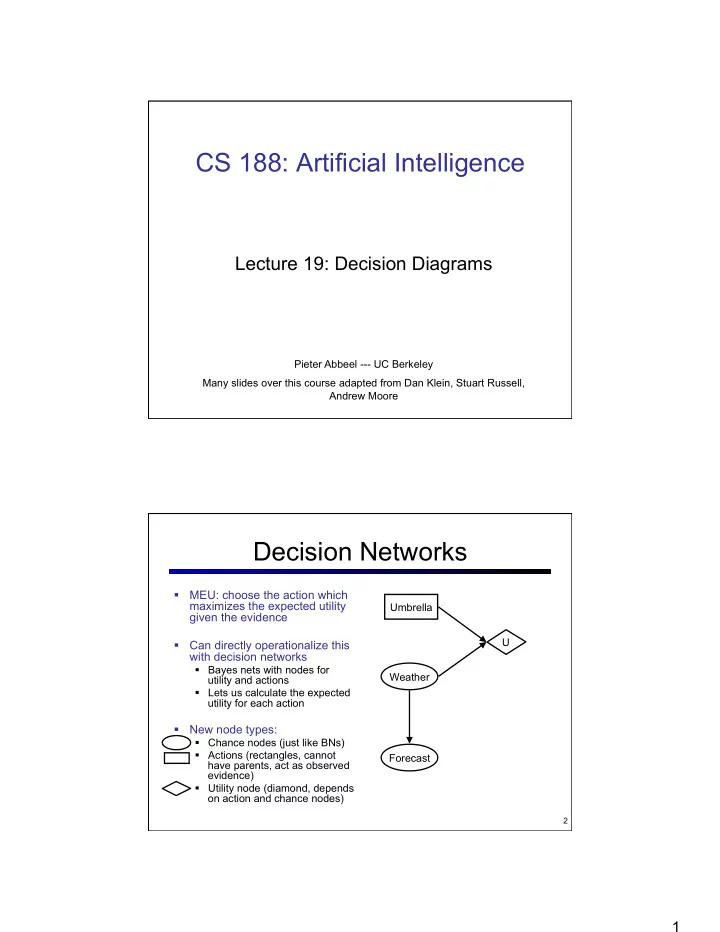

CS 188: Artificial Intelligence Lecture 19: Decision Diagrams Pieter Abbeel --- UC Berkeley Many slides over this course adapted from Dan Klein, Stuart Russell, Andrew Moore Decision Networks § MEU: choose the action which maximizes the expected utility Umbrella given the evidence U § Can directly operationalize this with decision networks § Bayes nets with nodes for Weather utility and actions § Lets us calculate the expected utility for each action § New node types: § Chance nodes (just like BNs) § Actions (rectangles, cannot Forecast have parents, act as observed evidence) § Utility node (diamond, depends on action and chance nodes) 2 1
Decision Networks § Action selection: Umbrella § Instantiate all evidence U § Set action node(s) each possible way § Calculate posterior Weather for all parents of utility node, given the evidence § Calculate expected utility for each action Forecast § Choose maximizing action 3 Example: Decision Networks Umbrella = leave Umbrella U Weather Umbrella = take A W U(A,W) W P(W) leave sun 100 sun 0.7 leave rain 0 rain 0.3 take sun 20 Optimal decision = leave take rain 70 2
Decisions as Outcome Trees {} leave e k a t Weather | {} Weather | {} sun sun rain rain U(t,s) U(t,r) U(l,s) U(l,r) § Almost exactly like expectimax / MDPs § What ’ s changed? 5 Example: Decision Networks W P(W|F=bad) Umbrella Umbrella = leave sun 0.34 rain 0.66 U Weather Umbrella = take A W U(A,W) leave sun 100 leave rain 0 take sun 20 Forecast take rain 70 =bad Optimal decision = take 6 3
Decisions as Outcome Trees {b} leave e k a t W | {b} W | {b} sun sun rain rain U(t,s) U(t,r) U(l,s) U(l,r) 7 Value of Information § Idea: compute value of acquiring evidence § Can be done directly from decision network DrillLoc § Example: buying oil drilling rights U § Two blocks A and B, exactly one has oil, worth k § You can drill in one location OilLoc § Prior probabilities 0.5 each, & mutually exclusive § Drilling in either A or B has EU = k/2, MEU = k/2 D O U O P a a k a 1/2 § Question: what ’ s the value of information of O? a b 0 b 1/2 § Value of knowing which of A or B has oil § Value is expected gain in MEU from new info b a 0 § Survey may say “ oil in a ” or “ oil in b, ” prob 0.5 each b b k § If we know OilLoc, MEU is k (either way) § Gain in MEU from knowing OilLoc? § VPI(OilLoc) = k/2 § Fair price of information: k/2 8 4
VPI Example: Weather MEU with no evidence Umbrella U MEU if forecast is bad Weather A W U MEU if forecast is good leave sun 100 leave rain 0 Forecast take sun 20 Forecast distribution take rain 70 F P(F) good 0.59 bad 0.41 9 Value of Information {+e} § Assume we have evidence E=e. Value if we act now: a P(s | +e) § Assume we see that E ’ = e ’ . Value if we act then: U {+e, +e ’ } a § BUT E ’ is a random variable whose value is unknown, so we don ’ t know what e ’ will be P(s | +e, +e ’ ) U § Expected value if E ’ is revealed and then we act: {+e} P(+e ’ | +e) P(-e ’ | +e) {+e, +e ’ } {+e, +e ’ } a § Value of information: how much MEU goes up by revealing E ’ first then acting, over acting now: 5
VPI Properties § Nonnegative § Nonadditive ---consider, e.g., obtaining E j twice § Order-independent 11 Quick VPI Questions § The soup of the day is either clam chowder or split pea, but you wouldn ’ t order either one. What ’ s the value of knowing which it is? § There are two kinds of plastic forks at a picnic. One kind is slightly sturdier. What ’ s the value of knowing which? § You ’ re playing the lottery. The prize will be $0 or $100. You can play any number between 1 and 100 (chance of winning is 1%). What is the value of knowing the winning number? 6
POMDPs s § MDPs have: § States S a § Actions A s, a § Transition fn P(s ’ |s,a) (or T(s,a,s ’ )) § Rewards R(s,a,s ’ ) s,a,s ’ s ’ § POMDPs add: b § Observations O a § Observation function P(o|s) (or O(s,o)) b, a § POMDPs are MDPs over belief o b states b (distributions over S) ’ § We ’ ll be able to say more in a few lectures 13 Example: Ghostbusters § In (static) Ghostbusters: b {e} § Belief state determined by a a evidence to date {e} b, a e, a § Tree really over evidence sets o e ’ § Probabilistic reasoning needed to predict new b {e, e ’ } evidence given past evidence ’ {e} § Solving POMDPs a bust a sense § One way: use truncated {e}, a sense expectimax to compute approximate value of actions U(a bust , {e}) e ’ § What if you only considered {e, e ’ } busting or one sense a bust followed by a bust? § You get a VPI-based agent! U(a bust , {e, e ’ }) 14 7
More Generally § General solutions map belief functions to actions § Can divide regions of belief space (set of belief functions) into policy regions (gets complex quickly) § Can build approximate policies using discretization methods § Can factor belief functions in various ways § Overall, POMDPs are very (actually PSACE-) hard § Most real problems are POMDPs, but we can rarely solve then in general! 15 8
Recommend
More recommend